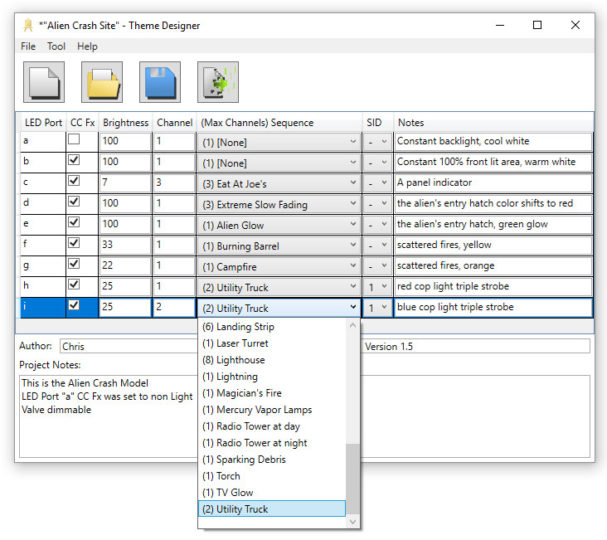Channels and LED Ports may be confusing at first. What is the difference?
- Channels are the brightness outputs of a sequence, named chn1, chn2 through chn16.
- Custom sequences often require only 1 to 3 channels
- LED Ports are the hardware outputs of the Morsel found on the green connectors, named a, b, c through i, 9 total.
It is the theme that connects channels to LED Ports. There is a ton of flexibility on how to connect them. This section is about sequences, not themes. So there is a reluctance to list all that flexibility here. But caution to the wind, here goes.
Theme Designer
Theme Designer is the bridge between channels and LED Ports. It lets you do several things. If you can’t remember all this flexibility, just notice the overall tonnage for now:
- Connect channels to LED Ports with a 1 to 1 correspondence
- chn1 to a, chn2 to b, etc.
- Re-map channels to Ports in any order
- chn1 to c, chn2 to b, chn3 to f, etc.
- Double the brightness or more
- chn1 to d, chn1 to f, chn1 to g (all three LED’s driven by chn1)
- Skip channels that won’t be needed
- chn1 to d, chn3 to b, (chn2 not needed)
- Adjust brightness of each LED Port
- d delivers 100%, e cranked down to 33%, etc.
- Use the CC pin to dim the brightness further
- b controlled by CC pin, c not controlled by CC pin, etc.
- Selective dimming by Light Valve
- Connect custom and preloaded sequences to different ports
- torch to a, custom 1 chn1 to c, custom3 chn4 to b, etc.
Multiplicity
Theme Designer has one more trick up its big sleeve. It can clone different copies of the same sequence. They will play in separate players as if different sequences entirely. And their channels can drive different LED ports with all the same flexibility listed above. If they contain randomness, they won’t behave alike.
- Two candles on ports g and i that don’t look alike
- Three custom2 sequences and two laser cannons on ports that all look different
It’s not as complicated as it may seem. You can see all these settings at a glance, on one compact table-style page of Theme Designer.

Test Theme
At last, we return to a basic case. To simplify testing, Sequence Composer allows exporting a sequence to a file on the Morsel called test.seq. At the same time, it loads an ultra-simple theme called test.prj that can’t be altered:
- No need to create a theme for debugging
- test.seq chn1 connects to LED Port a, chn2 to b and so on through chn9 to i
- all brightness at 100%
- no other sequences or adjustments included
- does not alter the contents of custom1, custom2 or custom3 sequence memories
The dim button on the Morsel continues able to dim these ports.
Test.seq and test.prj operate at full quality. If that contains everything you need, there may be no need to create a custom theme.
In summary, when we write a custom sequence, the outputs are called channels. When we create a custom theme, those channels are connected to the LED Ports any way we choose.
